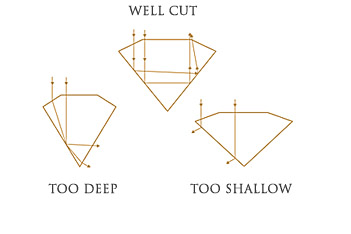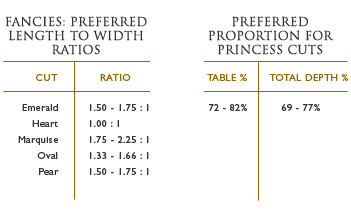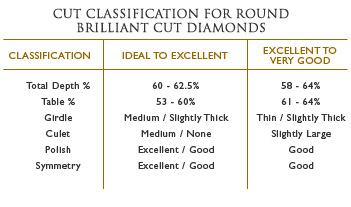Shape & Cut

 Cut refers not only to well known and newer shapes into which diamonds are made, but the proportions and finish given to each one by a highly skilled craftsman.
Cut refers not only to well known and newer shapes into which diamonds are made, but the proportions and finish given to each one by a highly skilled craftsman.
Round diamonds, because they are symmetrical in shape, are more easily standardized and most highly scrutinized for good cut. We analyze proportions in terms of how they affect light return. Every angle, proportion and facet in a cut diamond contributes to its optical efficiency and therefore its beauty.
If the pavilion is too shallow or too deep, light leaks out the stone and does not return to the eye. Table size and crown angle combine to balance brilliance (the flash coming from the stone’s surface) and dispersion (the fire or sparkle) within the stone.
Symmetry refers to the exactness of the shape and arrangement of facets or alignment. Polish refers to the surface condition of the stone, including minor blemishes and other characteristics that do not influence the clarity grade. Together, polish and symmetry are classified as the diamond’s finish.
 While there is no agreement on one formula to define the perfect cut for a round diamond, narrow ranges of proportion or cut class are frequently used to distinguish higher quality, more costly made diamonds from lower quality, more cheaply made diamonds. At Goldstock, we reject poorly cut diamonds. We can show you the differences between the better and the best cut diamonds available on the market today.
While there is no agreement on one formula to define the perfect cut for a round diamond, narrow ranges of proportion or cut class are frequently used to distinguish higher quality, more costly made diamonds from lower quality, more cheaply made diamonds. At Goldstock, we reject poorly cut diamonds. We can show you the differences between the better and the best cut diamonds available on the market today.
In the vast and growing range of fancy shapes, proportion becomes more easily determined by customer preference as to the overall appearance or outline of the diamond. For many fancy shapes, the length to width ratio is the most obvious and important factor.

